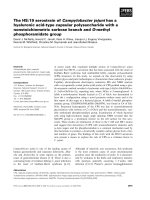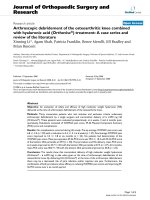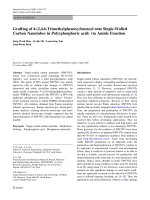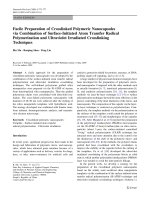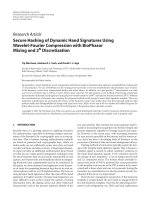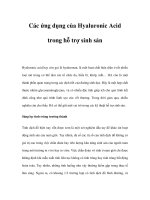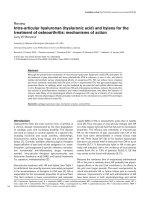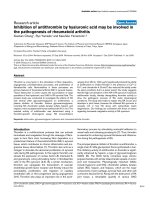Labile crosslinked hyaluronic acid via urethane formation using bis(βisocyanatoethyl) disulphide with tuneable physicochemical and immunomodulatory properties
Bạn đang xem bản rút gọn của tài liệu. Xem và tải ngay bản đầy đủ của tài liệu tại đây (3.79 MB, 10 trang )
Carbohydrate Polymers 245 (2020) 116501
Contents lists available at ScienceDirect
Carbohydrate Polymers
journal homepage: www.elsevier.com/locate/carbpol
Labile crosslinked hyaluronic acid via urethane formation using bis(βisocyanatoethyl) disulphide with tuneable physicochemical and
immunomodulatory properties
T
Fernanda Zambonia,b, Elizabeth Ryanb, Mario Culebrasa, Maurice N. Collinsa,b,*
a
b
Bernal Institute, School of Engineering, University of Limerick, Ireland
Health Research Institute, University of Limerick, Ireland
ARTICLE INFO
ABSTRACT
Keywords:
Hyaluronic acid
Diisocyanate
Crosslinking
Biocompatibility
Immunomodulation
Here, we synthesise a new isocyanate-based crosslinker with the aim of obtaining novel tailored gels. The newly
crosslinked hyaluronic acid (HA) gels were analysed in terms of rheological properties, chemical structure,
swelling, biocompatibility and immunological response. Results show that the synthesised di-isocyanate outperforms other more conventional di-isocyanates due to its alkyl-based which has been shown to be slower to
degrade by hydrolysis than aryl isocyanates. The alkyl-based isocyanate reacts readily with hydroxyl groups on
the HA to form stable carbamate crosslinkages. Importantly and uniquely, a centrally located disulphide bond
allows versatility with respect to reversible crosslinking and this allows potentially controlled layer-by-layer
deposition of the HA for tailored pharmaceutical applications.
1. Introduction
Hyaluronic acid (HA) is a glycosaminoglycan (GAG) constituted
with repeating units of a disaccharide that contains β-1,4-D-glucuronic
acid and β-1,3-N-acetyl-D-glucosamine. HA is a carbohydrate polymer
best known for its intrinsic hydrating properties, which acts as a space
filler, lubricant, and osmotic buffer that is found in the synovial fluid, in
the vitreous fluid and in the extra cellular matrix (ECM) of many tissues
in the body (Zamboni et al., 2017). However, HA also possesses important properties regarding its immunomodulatory activity which is
primarily dependent on its molecular size (Zamboni, Vieira, Reis,
Oliveira, & Collins, 2018).
For these reasons, it is understandable why HA is a material of increasing significance to biomaterials science and why it is finding applications in a wide range of areas that include drug delivery (Liu,
Wang, Yang, Zhang, & Gan, 2019) and body repair (Souness, Zamboni,
Walker, & Collins, 2018)
However, since HA is readily degraded in physiological conditions
due to hydrolysis and enzymatic degradation (Collins & Birkinshaw,
2007; Pandey & Weigel, 2014; Valachova et al., 2016), it is necessary to
prolong its degradation time through a variety of chemical modifications (Collins & Birkinshaw, 2007; Sigen et al., 2018, 2020; Zamboni
et al., 2018). The presence of hydroxyl groups in the N-acetylglucosamine moiety of HA is one of the main domains for crosslinking
⁎
via chemical reaction and covalent bond formation (Schante, Zuber,
Herlin, & Vandamme, 2011). Therefore, the development of new
covalent crosslinking chemistries is of critical importance to tailor the
structural stability of HA.
Up to date, in the literature only twice HA was crosslinked using
molecules bearing isocyanate groups (Chen et al., 2010; Dhanasingh,
Salber, Moeller, & Groll, 2010). The main advantage of using isocyanates is their reactivity towards hydroxyl groups to form urethane
linkages (Koniev & Wagner, 2015) and there is an increasing interest to
crosslink carbohydrate polymers with isocyanates (Sonker et al.,
2018b). Herein, it is proposed to use a novel diisocyanate as a crosslinking agent to react with the hydroxyl group present in the N-acetylglucosamine moiety of HA to form a gel through an urethane crosslinkage formation.
The novel bis(β-isocyanatoethyl) disulphide (BIED) has many advantages over other conventionally used diisocyanates. BIED is an
alkyl-based isocyanate, whose chemistry is known to be significantly
slower to degrade by hydrolysis than aryl isocyanates (Brown, Green,
Cedel, & Cairns, 1987). Moreover, alkyl-based isocyanates also produce
upon reaction with hydroxyl groups more stable urethane linkages
against thermal degradation which transfers to more stable hydrogels at
body temperature (Chattopadhyay & Webster, 2009). Alkyl isocyanates
are not cytotoxic in contrast to aryl isocyanates (Touchet & CosgriffHernandez, 2016).The incorporation of a disulphide bond centering the
Corresponding author at: ER0-003, Engineering Research Building, University of Limerick, Ireland.
E-mail address: (M.N. Collins).
/>Received 27 March 2020; Received in revised form 1 May 2020; Accepted 22 May 2020
Available online 02 June 2020
0144-8617/ © 2020 The Author(s). Published by Elsevier Ltd. This is an open access article under the CC BY license
( />
Carbohydrate Polymers 245 (2020) 116501
F. Zamboni, et al.
diisocyanate molecule backbone, gives a versatile and key additional
property that can to be exploited for self-healing and reversible crosslinking gels (Bian et al., 2016; Griesser, Hetenyi, & Bernkop-Schnurch,
2018; Pepels, Filot, Klumperman, & Goossens, 2013). The re-oxidation
of free thiol groups into disulphide bonds can be performed using
oxidizing agents (metal ions and enzymes) or by a disulphide exchange
mechanism (Fernandes & Ramos, 2004).
Table 1
Formulation of different HA gels.
HA
BIED
Formulation 1
(mg/mL)
Formulation 2
(mg/mL)
Formulation 3
(mg/mL)
Formulation 4
(mg/mL)
30
24.6
30
49.3
70
24.6
70
49.3
2.3. HA crosslinking
2. Materials and methods
Homogeneous crosslinking of HA was carried for all physico-chemical and mechanical characterization assessments of the gels.
Homogeneous crosslinking reactions were performed using DMSO as
the solvent for the system reaction. It is anticipated that this reaction
condition is suitable for the encapsulation of drugs, as drugs are normally hydrophobic. However, for any biological experimentation, hydrogels must be free of organic solvents. To this end, HA films were
heterogeneously crosslinked with BIED via a diffusion mechanism. This
method was deemed a preferred method for all biocompatibility analysis.
2.1. Materials
HA, with an average molecular weight (Mw) of 1.20 MDa and 0.1
MDa, was kindly supplied by Shanghai Easier Industrial Development
Co. LTD (Shanghai, China) as dry powder. 3,3′-dithiodipropionic acid,
hydrazine monohydrate, sodium nitrite, dimethyl sulphoxide (DMSO),
dithiothreitol (DTT) were purchased from Lennox Laboratories (Dublin,
Ireland). Alamar Blue cell viability reagent was purchased from
Invitrogen (Paisley, UK). Mouse granulocyte macrophage colony stimulating factor (GM-CSF) ELISA MAX Deluxe set and human tumour
necrosis factor (TNF) alpha ELISA MAX standard set were purchased
from BioLegend (San Diego, CA, USA). 4,6-Diamidino-2-phenylindole,
dihydrochloride (DAPI) was purchased from ThermoFisher Scientific.
PD5 silicon oil was purchased from Momentive. The dyalisis kit (Pur-ALyzer™ Mega 1000), deuterium oxide (D2O), Ellman’s Reagent (5,5′dithio-bis-(2-nitrobenzoic acid), fluorescein isothiocyanate (FITC) dextranes, Alamar blue (AB), ethylenediaminetetraacetic acid disodium
salt dihydrate (EDTA), sodium phosphate dibasic dihydrate, Dulbecco’s
modified Eagle Medium (DMEM), Roswell Park Memorial Institute
(RPMI) medium, trypsin-EDTA 0.25 %, foetal bovine serum (FBS),
phosphate buffered saline (PBS), L-glutamine and antibiotics and all
other reagents used in this work were of analytical grade purchased
from Sigma Aldrich (St. Louis, MO, USA). L929 fibroblast cell line derived from mouse and THP-1 monocyte cell line derived from human
were purchased from commercial sources.
2.3.1. Homogeneous crosslinking
BIED was added to different concentrations of HA MW 1.20 MDa or
0.1 MDa dissolved in DMSO. 1 M HCl was used to adjust the pH to 4.
The crosslinking reaction proceeds upon stirring. Formulations are
shown in Table 1 (below).
2.3.2. Heterogeneous crosslinking
HA solutions of 1.2 MDa 3% (w/v) and 0.1 MDa 7% (w/v) in water
were prepared overnight at 25 °C and 100 RPM. The difference in the
solution concentration was based solely on the viscosity of each MW
used. Concentrations over 3% for 1.2 MDa were much more difficult to
prepare homogenous solutions. Solutions were poured in petri dishes
and dried overnight at 35 °C in a fan oven to form the dried films. Dried
films were measured using a caliper as follows: 0.1 MDa films had an
average thickness of 0.066 mm ( ± 0.013) and 1.2 MDa films had an
average thickness of 0.156 mm ( ± 0.123). Films were cut in 1cm²
shape and weighted as follows: 0.1 MDa cm² films had an average
weight of 11 mg ( ± 1.1) and 1.2 MDa films had an average weight of
6.8 mg ( ± 0.47). Square films were then placed in a 1 mL solution of
acetone:water (80:20). Then, 400 mg/mL of BIED were added and pH
adjusted to 4 as described previously and allowed to crosslink for 72 h
at RT. Crosslinked films were washed with deionized water several
times before being dried for 3 h at 35 °C in a fan oven. Prior to testing,
crosslinked films were allowed to re-swell for 30 min at 37 °C with
deionized water. For glutaraldehyde (GLUT)-crosslinked HA, the same
heterogeneous crosslinking procedure was adopted. HA solutions of 1.2
MDa 3% (w/v) were dried overnight at 35 °C in a fan oven to form the
dried films. 1 cm2 films were then placed in a 1 mL solution of acetone:water (80:20) with GLUT. Films were allowed to crosslink for 72 h
at RT. Crosslinked films were washed with deionized water several
times before being dried for 3 h at 35 °C in a fan oven. Prior to testing,
crosslinked films were allowed to re-swell for 30 min at 37 °C with
deionized water.
2.2. Bis(β-isocyanatoethyl) disulphide synthesis
BIED is syntesised in three steps. Firstly, 3,3′-dithiodipropionic acid
(10 g) with ethanol in excess (22 g) were dissolved in toluene (100 mL)
with ρ-toluene sulfonic acid (2.5 %) as the reaction catalyst. The reaction was heated to boiling with temperature constantly monitored
using a thermocouple. The reaction was performed under reflux for 5 h
using a Dean-Stark trap to produce diethyl 3−3’-thiodipropionate. The
yield of the product was obtained by the evaporation of toluene using a
rotary evaporator (Rotavapor R-210, Buchi, Switzerland), giving a yield
of 90 %. In the second step, diethyl 3−3’-thiodipropionate (10 g) and
hydrazine monohydrate in excess (12 g) were dissolved in methanol (13
mL) and heated for 4 h under reflux to obtain dithiodipropionate dihydrazine after crystalization in an ice bath. The yield of the product
was calculated by the evaporation of methanol using a Gallenkamp
vacuum oven at a temperature of 40 °C overnight, obtaining a yield of
97 %. In the final step, dithiodipropionate dihydrazine (10 g) was
dissolved in HCl 2.5 M (60 mL) and stirred in an ice bath. 16 mL of a
sodium nitrite aqueous solution (76 %) was added drop wise to avoid
an extreme exothermic reaction. After, toluene (100 mL) is added to the
solution, and this induces a phase separation which is seperated using a
separation funnel. The toluene phase contained an intermediate product that upon heating produces BIED by curtius rearrangement. The
toluene is then refluxed for 10 min to completely convert acid hydrazine into isocyanate (pale yellow liquid). Toluene (bp: 110 °C) is
removed from BIED (bp: 148 °C) by using a rotary evaporator (BUCHI,
Switzerland) at 40 °C and under 29 mbar for 2 h (yield of 38 %). The
overall yield was calculated to be 33.17 %.
2.4. Fourier transform infrared spectroscopy (FT-IR)
All spectra were recorded on a Perkin Elmer spectrum 100 FT-IR
spectrometer operating in Attenuated Total Reflectance (ATR) mode.
Each FT-IR spectrum was scanned 20 times with a resolution of 2 cm–1.
The ranges used were from 4000 to 650 cm–1.
2.5. Rheology
The rheological properties of HA gels produced from BIED
2
Carbohydrate Polymers 245 (2020) 116501
F. Zamboni, et al.
Fig. 1. Stepwise synthesis reaction to produce BIED.
crosslinking were evaluated by the Discovery Hybrid Rheometer (DHR2) from TA Instruments using parallel plate geometry of 25 mm at 25
°C. Prior to oscillatory frequency measurements, a strain sweep analysis
was performed using a strain range of 0.01−0.1-1−10-100−1000%,
at a fixed frequency of 1 Hz to obtain the linear viscoelstic region of the
gels (0.01–1 %). Then, a frequency sweep was conducted in the frequency range of 0.1−10 Hz.
solvent interaction parameter (0.473).
The effective crosslink density, νe, was then calculated as follows:
ve =
The swollen hydrogel mesh size ξ (nm), was determined with the
following equation adapted from Collins et al. (Collins & Birkinshaw,
2008a):
2.6. Swelling
1
= 0.1748 Mc 1 +
HA gels were prepared as described previously and dried in an oven
at 70 °C for 24 h. The HA dry samples were weighed and incubated in 4
mL of PBS with pH 7.4 at RT. Hydrogels were removed at various time
intervals; excess solution was wiped off and sample weights were recorded. Swelling ratios (SR) were calculated as follows:
SR =
2.6.1. Characterization of the matrix of gels
HA hydrogels were dried in an oven at 70 °C, overnight. The dried
gels were subsequently swollen in PBS until they reached their equilibrium water content.
Crosslink densities were assessed by measuring volumetric swelling
and applying a simplified version of the Flory-Rehner equation as described by Collins et al. (Collins & Birkinshaw, 2008a).
Mc
(QM
(
1
2
1)
1)
3
After the crosslinking of HA to produce gels, the disulphide bond in
the spacer chain of the crosslinker was reduced to form free thiol
groups. First, gels had their pH adjusted to 7 using a solution of NaOH 1
M, then the gels were treated with DTT under heat until gels turned into
solution, see S1. HA was precipitated from the solution using acetone,
re-dissolved in DMSO and dyalised against deionized water. HA was
freeze dried to obtain a lyophilized powder.
The lyophilized powder of HA bearing free thiol groups was using
the Ellman’s Reagent. Briefly, samples and a stardant curve of L-cysteine
were prepared and incubated with Ellman’s solution and buffer for 15
min and absorvance was read at 412 nm, as described by the manufacturer. The absorbance from samples were applied to the standard
curve linear equation and concentration of free thiol groups in the HA
samples was obtained.
HA thiolation was confirmed using a Proton Liquid Nuclear
Magnetic Resonance (NMR) (Jeol ECX 400 NMR Jeol USA, Inc).
Samples were diluted in 1 mL of D2O. 128 scans were performed at RT
with a 15 Hz sample spinning and 45° tip angle.
where Wd is the dry weight and Ws is the weight of the sample after the
incubation time. All swelling measurements were carried out in triplicate.
s
s
(QM
2.7. Degree of substitution of HA gels
Ws
Wd
1+
Mc
5 3
* V1
)v
2.8. Permeability test
where Mc is the average molecular weight between crosslinks, ρp is the
density of the dry polymer (1.229 g/cm3) and ρs is the density of PBS.
QM is the swelling ratio determined experimentally by comparing the
mass of the material before and after immersion, ¯ is the specific volume of the dry polymer as the inverse of density, V1 is the molar volume of the solvent (18 cm3/mol for PBS), and χ is the Flory polymer
For the permeability test, 0.1 and 1.2 MDa films were heterogeneously crosslinked using BIED. The permeability experiment consists of HA-BIED crosslinked films separating the donor solution from
the acceptor solution. The donor solution contains 2 mg/mL of two
3
Carbohydrate Polymers 245 (2020) 116501
F. Zamboni, et al.
distinct FITC-dextranes with molecular weights of 4,000 and 150,000
Da, whilst PBS 1X was the acceptor solution. An in-house permeation
chamber made of PLA was 3D printed for these experiments using 3D
printer MakerGear M3ID (USA) and designed using Simplify3D software as shown in Fig. 1B. The two 3D-printed parts clip the gel in the
middle, separating the top chamber (with the donor solution) from the
bottom chamber (with the acceptor solution), see S2. Both chambers
hold a volume of 261 μL. The detection of FITC-dextran in the acceptor
solution is measured at different time intervals using a fluorescence
plate reader with an excitation wavelength of 485 nm and emission of
535 nm. A standard curve (0.066, 0.0032, 0.0016, 0.0008, 0.0004,
0.0002 mg/mL) for each FITC-dextran was measured and the linear
eqution was obtained to convert the fluorescence from the acceptor
solution into equivalent concentration. All tests were executed at RT
(Hsu et al., 2018). The calculation of the permeability coefficient was
determined according the equation below:
h, with or without LPS stimulation challenge (1:1000). After the incubation period, supernatant was collected by centrifugation and analysed for the production of TNF-alpha, a pro-inflammatory cytokine as
described by the ELISA kit manufacturer. L929 fibroblast cells at a
density of 20.000 cells/well were seeded onto crosslinked films of HA
1.2 and 0.1 MDa for 24, 48 and 72 h in a 96 well-plate. After the incubation period, supernatant was collected by centrifugations and
analysed for the production of GM-CSF, a cytokine that induces macrophage differentiation as part of the immune response chain, using an
ELISA kit as described by the manufacturer.
2.10. Statistical analysis
Data are presented as mean ± standard deviation (s.d.) and analysed using two-way analysis of variance (ANOVA). p-values < 0.05 (*)
were considered to be significant.
dCA
CD
= P*A*
dt
VA
3. Results and discussion
Where dCA/dt is the exchange of the concentration of the substance
within the acceptor side over time (the slope); CD is the concentration of
the donor solution; P is the permeability coefficient; A is the permeation
surface; and VA is the volume of the acceptor solution. This equation is
derived from Fick’s First Law and can only be applied when
CD > > CA.
3.1. BIED synthesis and HA crosslinking
Di-isocyanate was synthesized according to the reaction scheme in
Fig. 1. In order to chemically verify the product, FTIR analysis was
carried after each step. Fig. 2 shows the expected characteristic vibrational bands for each reaction product. For example, in step one the
starting material is a carboxylic acid that is converted into an ester. The
bands for carboxylic acid do not appear following the completion of the
reaction (OeH broad stretching band between 3,300−2,500 cm−1)
and the characteristic band for the ester, i.e. the C]O stretch band at
1735 cm−1 becomes apparent. In step two, the characteristic ester band
2.9. Biocompatibility
For the biocompatibility test, 0.1 and 1.2 MDa films were heterogeneously crosslinked using BIED as described in Section 2.3.2. Prior to
the biocompatibility test, these films were sterilized using UV radiation
for 1 h and allowed to re-swell for 30 min at 37 °C in the incubator
using cell growth medium. L929 cells were cultured in DMEM and
RPMI (respectively) with 10 % FBS, 1% streptomycin-penicillin solution and 2 mM of L-glutamine at 37 °C with 5% CO2 in a humidified
atmosphere. This medium was replenished every three days until 80 %
confluence was reached.
For the viability study, L929 cells were quantified by resazurin Alamar Blue (AB) -metabolic activity assay. Due to AB redox nature, in
which the oxidized form of AB (substrate) contained in the medium is
reduced (product) by the various components of the cellular respiration
chain (when cells are dead, they lose the ability to convert the substrate
into product), the reduced form of AB is proportional to the number of
viable cells present in the different planes of a 3-D microenvironment,
being able to provide a quantitative analysis of cell viability and, assuming that the metabolic activity maintains constant throughout the
testing conditions, quantification of cell proliferation is also possible.
L929 cells were seeded onto HA 1.2 and 0.1 MDa crosslinked films and
into the well (control group) of a 24 well-plate at a concentration of
50.000 cells/mL (n = 3). After an initial four hours of incubation to
allow cell attachment, AB was added to the media at a concentration of
10 % as specified by the manufacturer. The well plates were returned to
the incubator and aliquots of the media were taken at 4 h, 24 h and 48 h
of incubation to provide a continuous monitoring of cell culture over
time. Aliquots were measured in a 96 well-plate and fluorescence
readings were performed at 540 nm and 590 nm using a SynergyMx
plate reader (BioTek, EUA).
For cell attachment analysis, L929 cells were seeded onto HA 1.2
and 0.1 MDa crosslinked films for 24 h and 48 h. Cell nuclei was stained
using DAPI. Cell fluorescence imaging was captured using cellSens
software and the Olympus BX60 fluorescence microscope (Olympus,
Japan).
Fig. 2. FTIR spectra of the reaction products from the BIED synthesis. 3,3′dithiodipropionic acid, diethyl 3-3′-thiodipropionate dithiodipropionate dihydrazine and BIED.
2.9.1. Cytokine quantification
For the immune activation analysis, THP-1 cells at a density of
50,000 cell/mL were seeded onto HA 1.2 MDa crosslinked films for 24
4
Carbohydrate Polymers 245 (2020) 116501
F. Zamboni, et al.
Fig. 3. Schematic reaction between HA and BIED and representative image of the BIED-crosslinked HA gels with MW of 1.2 MDa. A) Crosslinked HA shows the
formation of urethane bond between isocyanate and the hydroxyl group. B) Formulation four retains its shape. C) Formulation three exhibits poor structural stability.
D) Representative FTIR spectra of HA and HA-BIED crosslinked gel dispaying the characterisitic urethane bridges.
now disappears, and new bands relating to the product appear. These
bands are related to NeH stretching 3,400−2,800 cm−1 which overlap
with primary amine (-NH2) stretch bands at 3,180 cm-1 and 3,320 cm−1
and the carbonyl of the acyl amino at 1,622 (Xu, Guan, Zhou, & Zhu,
2017).
Step two (a) involves a reaction between the dithiodipropionate
dihydrazine and nitrous acid (which is formed in situ between the reaction of sodium nitrite and hydrochloric acid) producing an intermediate compound called acyl azide. The azide (-N3) asymmetric
stretching vibration band is shown in Fig. 2 and was previously described in the literature at 2,162 nm (Tanver, Huang, Luo, Khalid, &
Hussain, 2015). After the acyl azide compound is extracted from the
aqueous solution using toluene via phase separation, it is subsequently
heated and converted into BIED by the Curtius rearrangement mechanism. BIED shows a characteristic broad and strong band at 2,262
cm−1 associated to isocyanates (Beck et al., 2009).
The synthesized di-isocyanate compound was then used to crosslink
HA in order to improve HA structural stability, as shown in the reaction
schematic in Fig. 3A. The hydroxyl groups of the N-acetylglucosamine
moiety of HA is targeted by the isocyanate to form an urethane linkage.
A representative image of 1.2 MDa HA hydrogels is shown in Fig. 3B
and C. In Fig. 3B, formulation 4 shows a stiffer gel that retains its shape
whereas in Fig. 3C formulation 3 shows a less stiff gel that does not hold
its shape. This result is expected, as higher crosslinking concentrations
react with more functional groups, thereby giving rise to higher
crosslinking densities and subsequently stiffer gels. In order to
5
Carbohydrate Polymers 245 (2020) 116501
F. Zamboni, et al.
chemically confirm that the isocyanate of BIED and HA reacted to form
urethane linkages, FTIR was performed as shown in Fig. 3D. The FTIR
spectrum of HA powder, shows the characteristic OH vibration band at
3346 cm−1 and the broad carbonyl band of the acid and the N-acetiylamide group at 1618 cm-1 (Dhanasingh et al., 2010). Once the
crosslinking reaction with BIED occurs, the HA hydrogel shows the
appearance of the characteristic carbonyl urethane group (C]O
stretching) at 1729 cm-1, carbamate group (CeN) at 1564 cm-1, and
CeOC at 1228 cm−e1 (Wong & Badri, 2012). The carbonyl band at
1729 cm-1 is regarded to be free of hydrogen bonding (Bahadur, Shoaib,
Saeed, & Iqbal, 2016). Importantly, the absence of the characteristic
isocyanate band at 2262 cm-1 indicates a fully crosslinked HA, where
there was no unreacted isocyanate groups (Sonker et al., 2018a). This is
an important finding because unreacted covalent crosslinkers with HA
is a common problem for HA based hydrogels and it can lead to biocompatibility issues. Furthermore, the increased OH vibration band at
3346 cm−1 showed in the BIED-crosslinked HA hydrogel comes from
embedded water.
indicating they were successfully crosslinked. The stiffness of a gel can
be modulated and controlled by varying crosslinking concentrations
and therefore crosslink densities. HA concentration and HA MW also
influence stiffness. For example, when the HA concentration is increased hydrogel stiffness increases (higher G’). Whilst, the use of
higher HA MW G’ (stiffness) decreases. With LMW HA gels displaying
storage moduli < 30 K Pa, whereas HMW HA gels displaying storage
moduli of ∼ 10 K Pa. To elucidate this further we examined the degree
of substitution of both formulation 4 by Ellman’s assay (shown in
Table 2) and confirmed through NMR, as shown in S1.
The degree of thiolation for 0.1 MDa was 4.16 μM/mg of HA as
opposed to 1.39 μM/mg of HA for 1.2 MDa HA, and is consistent with
the difference in crosslink densities, subsequent gel stiffness (∼ 10 kPa
for 0.1 MDa and ∼ 2 kPa for 1.2 MDa) and appearance. We hypothesise
that the thiolation degree decreases with increasing molecular weight
possibly due to the formation of hydrogen bonds which result in higher
viscosity. Also, longer polymeric chains are more likely to become entangled, which makes the sites for crosslinking difficult to reach via
diffusion, thus, causing lower reaction efficiency (Cao et al., 2019).
Bearing in mind, the main advantage of BIED over other isocyanates is
that it has a disulphide bond in the middle of the crosslinker chain,
which can be reduced into free thiol groups, and possibly re-oxidized
into disulphide bond for reversible or self-healing gel forming properties.
3.2. HA hydrogel structure function property relationships
The stiffness of HA hydrogels was evaluated through determination
of the storage (G’) and loss moduli (G’’), where G’ represents the elastic
component of the gel and G” represents the viscous component of the
gel as shown in Fig. 4. All gels produced in this study display G’ > G”,
3.2.1. Swelling characterization
The speed at which gels swell to their equilibrium water content is a
function of crosslink density and polymeric concentration, see Fig. 5.
The comparison between the different HA concentrations in the gel
(formulations one and two compared to formulations three and four),
shows that 70 mg/mL HA has higher water uptakes than 30 mg/mL HA
gels. When comparing crosslink densities, it is observed that LMW HA
gels show lower swelling ratios than HMW HA gels, this is mainly attributed to the fact that LMW HA gels are more efficiently crosslinked
than HMW HA gels.
The stability of the gels can be estimated by swelling studies.
Despite lower crosslink densities the HMW gels were more stable than
LMW gels and this was attributed to the higher molecular weight of HA.
Stability of the gels gradually decreases over time as glycosidic bonds in
the backbone of HA become more likely to be degraded (Cao et al.,
2019). When comparing 1.2 MDa HA gel, the stability of the four formulations progressively increased, of which formulation four is the
most stable, presenting no mass loss up to 24 h immersion in PBS at
room temperature.
Overall, hydrogel swelling ratios decrease with decreasing molecular weight, which is due to increased crosslinking density and the
formation of tighter network structures with an increasing number of
covalent crosslinks (Hegger et al., 2017). However, although low molecular weight hydrogels (0.1 MDa) display higher crosslinking densities, it is also the faster to degrade due to smaller and less entangled
polymeric chains where glycosidic bonds are more likely be degraded
by hydrolysis (Cao et al., 2019).
The gels initially turned white in colour, and then a colourless
swelling front moved inwards, separating the highly swollen surface
from the less swollen core of the gel and gradually the entire gel turned
colourless and was swollen evenly. This colour phenomenon was also
described by (Collins & Birkinshaw, 2008b) and it is presumed to be due
to molecular rearrangement as the water diffuses through the material.
3.2.2. Matrix characterization
In general, increasing effective crosslinking density decreases mesh
size and average MW between crosslinks (Collins & Birkinshaw, 2010)
and produces hydrogel matrices with smaller molecular weight cut-off
(MWCO) and slower permeation rates (Bal, Kepsutlu, & Kizilel, 2014;
Weber, Lopez, & Anseth, 2009). Hence, knowing these matrix parameters (shown in Table 2) is imperative for applications such as drug
Fig. 4. Rheological profile of BIED-crosslinked HA gels with a) MW of 1.2 MDa
and b) 0.1 MDa.
6
Carbohydrate Polymers 245 (2020) 116501
F. Zamboni, et al.
Table 2
Crosslinking parameters calculated for BIED-crosslinked HA gels.
HA MW
(MDa)
Formulation
Mesh size (nm)
Average MW between crosslinks (g mol−1)
Effective crosslinking density (mol cm−3)
Thiolation
(μM/mg of HA)
1.2
F1
F2
F3
F4
F1
F2
F3
F4
28.9 ± 3.9
32.2 ± 1.8
57.2 ± 5.2
113.9 ± 18.8
14.7 ± 3.1
9.9 ± 3.1
17.0 ± 0.3
17.3 ± 0.9
10,091.1 ± 2611.8
11,695.2 ± 1271.0
26,614.4 ± 4983.8
71,198.1 ± 22452
4983.7 ± 2099.8
2,309 ± 1333.6
5,100 ± 202.5
4,900 ± 520.1
0.000122 ± 3.73754E−05
0.000105 ± 1.22882E−05
0.000046 ± 8.14453E−06
0.000017 ± 6.65833E−06
0.00027 ± 0.00011
0.00069 ± 0.0004
0.00024 ± 6.35085E−06
0.00025 ± 2.6839E−05
–
–
–
1.39
–
–
–
4.16
0.1
± SD
dissolves a large variety of polar and non-polar small molecules, making
it an important drug solvent for pharmaceutical formulations (Tetko
et al., 2013). Furthermore, DMSO enhances drug delivery through
tissue and cell membranes causing no ill effects (Marren, 2011).
Matrix characterization of gels shown in Table 2 can be translated to
the heterogeneous BIED-crosslinking of HA hydrogels. LMW HA crosslinked via diffusion also shows slower permeation rates than HMW HA
hydrogels, implying higher crosslinking densities and lower mesh size
(Fig. 6).
For cell encapsulation, crosslinking needs to be conducted in physiological conditions, BIED-crosslinked HA gels can produce thiolated
HA derivates. Due to the fact that BIED contains a centralized disulphide bond, the gel can be reduced into a solution and the disulphide
bond can be severed into free thiol groups, that can be re-crosslinked
(Black, Sanders, & Stefankiewicz, 2014). Converting these thiol groups
into disulphide crosslinks can be achieved by thiol oxidation and disulphide exchange mechanisms. Thiol oxidation reactions need strong
oxidizing agents and catalysts to occur, which hamper its use for cell
encapsulation (Trost & Fleming, 1991; Milheiro et al., 2016; Scharf
et al., 2014; Wang et al., 2016; Dewan, Bora, & Kakati, 2012). On the
other hand, disulphide exchange mechanism occurs spontaneously via a
biomolecular nucleophilic substitution (SN2) reaction. This mechanism
allows the formation of gel in physiological conditions (aqueous
medium and neutral pH) (Fernandes & Ramos, 2004) that can present
self-healing properties (Pepels et al., 2013), and are suitable for cell
encapsulation.
As seen in Table 2, the reduction of BIED-crosslinked HA is possible
and it produces HA-bearing thiols, which were obtained for the quantification of the degree of substitution of HA which correlates to the
crosslinking degree. It can be postulated that these HA derivatesbearing thiol groups could be exploited for self-healing and for cell
encapsulation by the re-oxidation of thiols into disulphide bonds.
Therefore, we envisage that for cell encapsulation approaches, the
balance between mesh size and permeation rate is imperative to prevent the inflow of molecules like antibodies such as IgG (150 kDa),
Fig. 5. Swelling profiles of BIED-crosslinked HA gels of a) 1.2 MDa and b) 0.1
MDa.
delivery and cellular scaffolding. Here, the characterization of homogeneous BIED-crosslinked HA gels shows that LMW HA gels display
much smaller mesh sizes than HMW HA due to their higher crosslink
densities resulting from their higher degrees of thiolation. As mentioned before, BIED in HMW HA has lower reaction activity due to the
longer polymeric chains that are more likely to become entangled,
which makes sites for crosslinking difficult to reach (Cao et al., 2019).
It is envisaged that the homogeneous crosslinking carried out in this
study can potentially be used to encapsulate drugs. Additionally, the
use of DMSO can pose little constraint for drug encapsulation, as DMSO
Fig. 6. Permeation rate of different dextrans through HA gels of different molecular weight.
7
Carbohydrate Polymers 245 (2020) 116501
F. Zamboni, et al.
Fig. 7. Biocompatibility of HA-BIED crosslinked gels. A) Metabolic activity analysis of L929 cells over time. B) L929 cells fluorescently stained using DAPI. Cell
attachment on the surface of 0.1 MDa and 1.2 MDa HA films crosslinked with BIED at 24 and 48 h after incubation. Magnification 10 × .
cytokines such as IL-1 (17.5 kDa) and chemokines such as CCL-2 (8
kDa), while allowing the diffusion of oxygen and LMW biological
compounds such as glucose (180 Da) and carbon dioxide (44 Da) out of
the encapsulate.
For this reason, when comparing the crosslinking concentration
used to produce the gels, higher amounts of crosslinker produced gels
with lower mesh sizes. The smaller mesh size calculated for these gels,
was for LMW HA in Formulation 2. This hydrogel has a mesh size of 9.9
nm ( ± 3.1), which is capable of preventing IgG permeation, the most
abundant immunoglobulin (80 %) in the body with a Stokes-Einstein
radius of 6.4 nm (Karlsson, Zacchi, & Axelsson, 2002). Previous studies
have proven that membrane barriers for IgG are enough to prevent graft
rejection in transplants, indicating that blocking cytokines and chemokines may not be a requirement for immunosuppression in allotransplantation (Steele, Halle, Poncelet, & Neufeld, 2014). Thus, it is
expected that increasing the concentration of crosslinker to higher
amounts could be able to produce gels with much lower mesh size, thus
being able to act as an immunoprotective barrier with potential immunomodulatory properties.
3.2.3. Permeation study
To mimic the penetration rate of IgG (150 kDa) and CCL-2 (8 kDa)
through the HA hydrogels, two FITC-labelled dextranes of similar molecular weight were utilized to determine permeation rates through the
LMW and HMW HA hydrogel membranes.
The results shown in Fig. 6 demonstrate the delay of permeation of
150 KDa dextran in LMW HA gels (p < 0.05). However, HMW HA gels
were inefficient to delay the permeation of both 4 KDa and 150 KDa.
Due to the high size of its matrix mesh size, both particles were smaller
than the mesh, showing equal permeation rates.
8
Carbohydrate Polymers 245 (2020) 116501
F. Zamboni, et al.
increase in TNF-alpha secretion is observed for all test groups in comparison to the control group (well). Neither non-crosslinked nor BIEDcrosslinked HA elicited TNF-alpha production. Once monocytes are
challenged with LPS, a significant (p < 0.05) spike in TNF-alpha is
observed in all groups, however, BIED-crosslinked HMW HA shows to
protect monocytes from LPS-induced TNF-alpha production. This
finding correlates well with previous studies which have already established that HMW HA has the ability to suppress inflammation due to
LPS exposure in macrophages (Rayahin, Buhrman, Zhang, Koh, &
Gemeinhart, 2015).
5. Conclusion
In this study, HA of low and high molecular weight are crosslinked
using BIED, a di-isocyanate that possesses better characteristics (hydrolytic and thermal degradability, biocompatibility and reversible
disulphide bond) than commonly used aryl di-isocyanates, through the
formation of urethane linkages between the HA chains. Results show
that the obtained hydrogels exhibit tailored mechanical and stability
properties which depend on HA content, HA molecular weight and
degree of crosslinking. These parameters have been varied to design
hydrogels with predefined structure property relationships. HA hydrogels crosslinked with BIED were shown to be biocompatible, and to
elicit no cytotoxicity. Interestingly, the immunoresponse associated
with these hydrogels was due to HA MW solely. LMW HA hydrogels
increased fibroblast activation overtime, possibly due to a delayed and
progressive response, and HMW HA gels decreased fibroblast activation
overtime, possibly being related to an acute inflammatory response.
These results give an insight into how these materials can modulate
the immune system. For example, cellular grafts of LMW HA-BIED show
decreased fibroblast production of GM-CSF, indicating these grafts
could be transplanted into tissues abundant in fibroblasts. On the other
hand, cellular grafts of HMW HA-BIED show no monocyte activation
and TNF-alpha production, whilst protecting LPS induction, thus
showing the potential of being transplanted in tissues with direct blood
contact.
It is expected that these results will give an insight into the future
application of these hydrogels systems. For example, pro-inflammatory
LMW HA hydrogels could potentially be used for the delivery of vaccines, whilst, HMW HA hydrogels could potentially be used for cell
encapsulation to decrease immune rejection of transplanted cells.
Fig. 8. Immunomodulation of HA crosslinked gels A) L929 cell activation and
production of GM-CSF after incubation with HA-BIED crosslinked gels of 0.1
MDa and 1.2 MDa. B) THP-1 monocyte activation and production of TNF-alpha
at 24 h after incubation with 1.2 MDa HA and HA-crosslinked hydrogels using
glutaraldehyde and BIED. LPS challenge was performed to confirm monocyte
activation.
4. Biological analysis
4.1. Biocompatibility
In Fig. 7A, the biocompatibility of HA gels crosslinked with BIED is
shown. It is observed that crosslinked HA films show similar proliferation profile from non-crosslinked HA films, used as control groups.
Overtime, the metabolic activity of the cells has a lag time of 24 h
before increasing proliferation begins. Fig. 7B shows cells stained with
fluorescent DAPI at 24 and 48 h after being seeded onto crosslinked HA
films. It is shown that the number of cells increase overtime.
CRediT authorship contribution statement
Fernanda Zamboni: Conceptualization, Data curation, Formal
analysis, Funding acquisition, Investigation, Methodology, Resources,
Software, Validation, Visualization, Writing - original draft. Elizabeth
Ryan: Investigation. Mario Culebras: Data curation, Writing - review
& editing. Maurice N. Collins: Project administration, Supervision,
Writing - review & editing.
4.2. Immunomodulatory analysis
Briefly, fibroblast cells were chosen as they are present in all tissues
but predominantly in connective tissues and elicit immunological responses by aiding the immune system by producing proinflammatory
cytokines and chemokines to induce and recruit inflammatory cells
(Bautista-Hernandez, Gomez-Olivares, Buentello-Volante, & Manuel
Bautista-de Lucio, 2017). Fig. 8A shows GM-CSF, a cytokine secreted
from fibroblasts that induces macrophage differentiation as part of the
immune response chain.
GM-CSF production of 0.1 MDa HA crosslinked film is similar to
basal production of GM-CSF demonstrated by the control group
(p > 0.05). However, overtime, there is an increasing GM-CSF production trend. 1.2 MDa HA was able to elicit a rapid production of GMCSF within 24 h of incubation (p < 0.05), but overtime GM-CSF production decreases. Within the first 24 h, acute inflammatory response is
observed, but overtime, there isn’t a progression of inflammation,
showed by the decrease in production.
Fig. 8B shows the influence of HMW HA on the activation of
monocytes to produce TNF-alpha. It can be seen that no significant
Acknowledgement
This work was supported by the Irish Research Council (GOIPG/
2015/3577).
Appendix A. Supplementary data
Supplementary material related to this article can be found, in the
online version, at doi: />References
Bahadur, A., Shoaib, M., Saeed, A., & Iqbal, S. (2016). FT-IR spectroscopic and thermal
study of waterborne polyurethane-acrylate leather coatings using tartaric acid as an
ionomer. E-Polymers, 16(6), 463–474. />
9
Carbohydrate Polymers 245 (2020) 116501
F. Zamboni, et al.
Pandey, M. S., & Weigel, P. H. (2014). Hyaluronic acid receptor for endocytosis (HARE)mediated endocytosis of hyaluronan, heparin, dermatan sulfate, and acetylated low
density lipoprotein (AcLDL), but not chondroitin sulfate types A, C, D, or E, activates
NF-kappaB-regulated gene expression. The Journal of Biological Chemistry, 289(3),
1756–1767. />Pepels, M., Filot, I., Klumperman, B., & Goossens, H. (2013). Self-healing systems based
on disulfide-thiol exchange reactions. Polymer Chemistry, 4(18), 4955–4965. https://
doi.org/10.1039/c3py00087g.
Rayahin, J. E., Buhrman, J. S., Zhang, Y., Koh, T. J., & Gemeinhart, R. A. (2015). High and
low molecular weight hyaluronic acid differentially influence macrophage activation.
ACS Biomaterials Science & Engineering, 1(7), 481–493. />acsbiomaterials.5b00181.
Schante, C. E., Zuber, G., Herlin, C., & Vandamme, T. F. (2011). Chemical modifications
of hyaluronic acid for the synthesis of derivatives for a broad range of biomedical
applications. Carbohydrate Polymers, 85(3), 469–489. />carbpol.2011.03.019.
Scharf, B., Clement, C. C., Zolla, V., Perino, G., Yan, B., Elci, S. G., & Santambrogio, L.
(2014). Molecular analysis of chromium and cobalt-related toxicity. Scientific Reports,
4. />Sigen, A., Xu, Q., McMichael, P., Gao, Y., Li, X., Wang, X., & Wang, W. (2018). A facile
one-pot synthesis of acrylated hyaluronic acid. Chemical Communications, 54(9),
1081–1084. />Sigen, A., Zeng, M., Johnson, M., Creagh-Flynn, J., Xu, Q., Tai, H., ... Wang, W. (2020).
Green synthetic approach for photo-cross-Linkable methacryloyl hyaluronic acid with
a tailored substitution degree. Biomacromolecules. />biomac.0c00196.
Sonker, A. K., Belay, M., Rathore, K., Jahan, K., Verma, S., Ramanathan, G., ... Verma, V.
(2018a). Crosslinking of agar by diisocyanates. Carbohydrate Polymers, 202, 454–460.
/>Sonker, A. K., Belay, M., Rathore, K., Jahan, K., Verma, S., Ramanathan, G., ... Verma, V.
(2018b). Crosslinking of agar by diisocyanates. Carbohydrate Polymers, 202, 454–460.
/>Souness, A., Zamboni, F., Walker, G. M., & Collins, M. N. (2018). Influence of scaffold
design on 3D printed cell constructs. Journal of Biomedical Materials Research Part B:
Applied Biomaterials, 106(2), 533–545. />Steele, J. A., Halle, J. P., Poncelet, D., & Neufeld, R. J. (2014). Therapeutic cell encapsulation techniques and applications in diabetes. Advanced Drug Delivery Reviews,
67–68, 74–83. />Tanver, A., Huang, M.-H., Luo, Y., Khalid, S., & Hussain, T. (2015). Energetic interpenetrating polymer network based on orthogonal azido–alkyne click and polyurethane for potential solid propellant. RSC Advances, 5(79), 64478–64485. https://
doi.org/10.1039/C5RA10467J.
Tetko, I. V., Novotarskyi, S., Sushko, I., Ivanov, V., Petrenko, A. E., Dieden, R., & Mathieu,
B. (2013). Development of Dimethyl Sulfoxide Solubility Models Using 163 000
Molecules: Using a Domain Applicability Metric to Select More Reliable Predictions.
Journal of Chemical Information and Modeling, 53(8), 1990–2000. />1021/ci400213d.
Touchet, T. J., & Cosgriff-Hernandez, E. M. (2016). 1 - Hierarchal structure–property
relationships of segmented polyurethanes. In S. L. Cooper, & J. Guan (Eds.). Advances
in polyurethane biomaterials (pp. 3–22). Woodhead Publishing.
Trost, B. M., & Fleming, I. (1991). Comprehensive organic synthesis: Selectivity, strategy, and
efficiency in modern organic chemistry (1st ed.). Oxford, England; New York: Pergamon
Press.
Valachova, K., Topol’ska, D., Mendichi, R., Collins, M. N., Sasinkova, V., & Soltes, L.
(2016). Hydrogen peroxide generation by the Weissberger biogenic oxidative system
during hyaluronan degradation. Carbohydrate Polymers, 148, 189–193. https://doi.
org/10.1016/j.carbpol.2016.04.063.
Wang, D. L., Lin, Z. F., Wang, T., Yao, Z. F., Qin, M. N., Zheng, S. R., ... Lu, W. (2016).
Where does the toxicity of metal oxide nanoparticles come from: The nanoparticles,
the ions, or a combination of both? Journal of Hazardous Materials, 308, 328–334.
/>Weber, L. M., Lopez, C. G., & Anseth, K. S. (2009). The effects of PEG hydrogel crosslinking density on protein diffusion and encapsulated islet survival and function.
Journal of Biomedical Materials Research Part A, 90(3), 720–729. />1002/jbm.a.32134.
Wong, C. S., & Badri, K. H. (2012). Chemical analyses of palm kernel oil-based polyurethane prepolymer. Materials Sciences and Applications, 3, 9. />4236/msa.2012.32012.
Xu, X. N., Guan, X. N., Zhou, H. H., & Zhu, Y. F. (2017). One-step reduction and surface
modification of graphene oxide by 3-hydroxy-2-naphthoic acid hydrazide and its
polypropylene nanocomposites. Nanomaterials, 7(2), />nano7020025.
Zamboni, F., Keays, M., Hayes, S., Albadarin, A. B., Walker, G. M., Kiely, P. A., ... Collins,
M. N. (2017). Enhanced cell viability in hyaluronic acid coated poly(lactic-co-glycolic
acid) porous scaffolds within microfluidic channels. International Journal of
Pharmaceutics, 532(1), 595–602. />Zamboni, F., Vieira, S., Reis, R. L., Oliveira, J. M., & Collins, M. N. (2018). The potential
of hyaluronic acid in immunoprotection and immunomodulation: Chemistry, processing and function. Progress in Materials Science, 97, 25. />pmatsci.2018.04.003.
Bal, T., Kepsutlu, B., & Kizilel, S. (2014). Characterization of protein release from poly
(ethylene glycol) hydrogels with crosslink density gradients. Journal of Biomedical
Materials Research Part A, 102(2), 487–495. />Bautista-Hernandez, L. A., Gomez-Olivares, J. L., Buentello-Volante, B., & Manuel
Bautista-de Lucio, V. (2017). Fibroblasts: The unknown sentinels eliciting immune
responses against microorganisms. European Journal of Microbiology & Immunology,
7(3), 151–157. />Beck, J. B., Killops, K. L., Kang, T., Sivanandan, K., Bayles, A., Mackay, M. E., & Hawker,
C. J. (2009). Facile Preparation of Nanoparticles by Intramolecular Cross-Linking of
Isocyanate Functionalized Copolymers. Macromolecules, 42(15), 5629–5635. https://
doi.org/10.1021/ma900899v.
Bian, S. Q., He, M. M., Sui, J. H., Cai, H. X., Sun, Y., Liang, J., & Zhang, X. D. (2016). The
self-crosslinking smart hyaluronic acid hydrogels as injectable three-dimensional
scaffolds for cells culture. Colloids and Surfaces B-Biointerfaces, 140, 392–402. https://
doi.org/10.1016/j.colsurfb.2016.01.008.
Black, S. P., Sanders, J. K. M., & Stefankiewicz, A. R. (2014). Disulfide exchange: Exposing
supramolecular reactivity through dynamic covalent chemistry. Chemical Society
Reviews, 43(6), 1861–1872. />Brown, W. E., Green, A. H., Cedel, T. E., & Cairns, J. (1987). Biochemistry of proteinisocyanate interactions – A comparison of the effects of aryl vs alkyl isocyanates.
Environmental Health Perspectives, 72, 5–11. />Cao, W., Sui, J., Ma, M., Xu, Y., Lin, W., Chen, Y., & Zhang, X. (2019). The preparation
and biocompatible evaluation of injectable dual crosslinking hyaluronic acid hydrogels as cytoprotective agents. Journal of Materials Chemistry B, 7(28), 4413–4423.
/>Chattopadhyay, D. K., & Webster, D. C. (2009). Thermal stability and flame retardancy of
polyurethanes. Progress in Polymer Science, 34(10), 1068–1133. />1016/j.progpolymsci.2009.06.002.
Chen, J.-H., Tsai, B.-H., Chang, H.-T., Chen, M.-L., Chen, Y.-H., Jan, S.-H. … Liu, M.-J.
(2010). U. S. Patent.
Collins, M. N., & Birkinshaw, C. (2007). Comparison of the effectiveness of four different
crosslinking agents with hyaluronic acid hydrogel films for tisslue-culture applications. Journal of Applied Polymer Science, 104(5), 3183–3191. />1002/app.25993.
Collins, M. N., & Birkinshaw, C. (2010). Morphology of crosslinked hyaluronic acid
porous hydrogels. Journal of Applied Polymer Science, 120(2010), 10.
Collins, M. N., & Birkinshaw, C. (2008a). Investigation of the swelling behavior of
crosslinked hyaluronic acid films and hydrogels produced using homogeneous reactions. Journal of Applied Polymer Science, 109(2), 923–931. />app.27631.
Collins, M. N., & Birkinshaw, C. (2008b). Physical properties of crosslinked hyaluronic
acid hydrogels. Journal of Materials Science-Materials in Medicine, 19(11), 3335–3343.
/>Dewan, A., Bora, U., & Kakati, D. K. (2012). A mild and efficient protocol for oxidation of
thiols to disulfides in water. Heteroatom Chemistry, 23(2), 231–234. />10.1002/hc.20760.
Dhanasingh, A., Salber, J., Moeller, M., & Groll, J. (2010). Tailored hyaluronic acid hydrogels through hydrophilic prepolymer cross-linkers. Soft Matter, 6(3), 618–629.
/>Fernandes, P. A., & Ramos, M. J. (2004). Theoretical insights into the mechanism for
thiol/disulfide exchange. Chemistry - A European Journal, 10(1), 257–266. https://doi.
org/10.1002/chem.200305343.
Griesser, J., Hetenyi, G., & Bernkop-Schnurch, A. (2018). Thiolated hyaluronic acid as
versatile mucoadhesive polymer: From the chemistry behind to product developments-what are the capabilities? Polymers, 10(3), />polym10030243.
Hegger, P. S., Kupka, J., Minsky, B. B., Schädel, N., Petri, N., Laschat, S., ... Boehm, H.
(2017). Charge matters: Modulating secondary interactions in hyaluronan hydrogels.
ChemistrySelect, 2(25), 7701–7705. />Hsu, H. H., Kracht, J. K., Harder, L. E., Rudnik, K., Lindner, G., Schimek, K., & Portner, R.
(2018). A method for determination and simulation of permeability and diffusion in a 3D
tissue model in a membrane insert system for multi-well plates. ss(132) />10.3791/56412 e56412.
Karlsson, D., Zacchi, G., & Axelsson, A. (2002). Electronic speckle pattern interferometry:
A tool for determining diffusion and partition coefficients for proteins in gels.
Biotechnology Progress, 18(6), 1423–1430. />Koniev, O., & Wagner, A. (2015). Developments and recent advancements in the field of
endogenous amino acid selective bond forming reactions for bioconjugation (vol 44,
pg 5495, 2015). Chemical Society Reviews, 44(15), />c5cs90060c 5743-5743.
Liu, Y., Wang, Y., Yang, J., Zhang, H., & Gan, L. (2019). Cationized hyaluronic acid coated
spanlastics for cyclosporine A ocular delivery: Prolonged ocular retention, enhanced
corneal permeation and improved tear production. International Journal of
Pharmaceutics, 565, 133–142. />Marren, K. (2011). Dimethyl sulfoxide: An effective penetration enhancer for topical
administration of NSAIDs. The Physician and Sportsmedicine, 39(3), 75–82. https://
doi.org/10.3810/psm.2011.09.1923.
Milheiro, A., Nozaki, K., Kleverlaan, C. J., Muris, J., Miura, H., & Feilzer, A. J. (2016). In
vitro cytotoxicity of metallic ions released from dental alloys. Odontology, 104(2),
136–142. />
10

